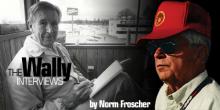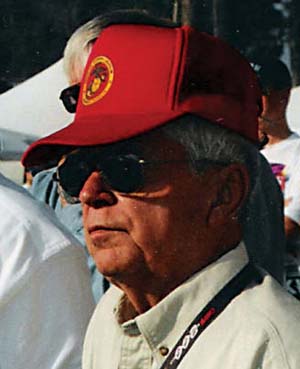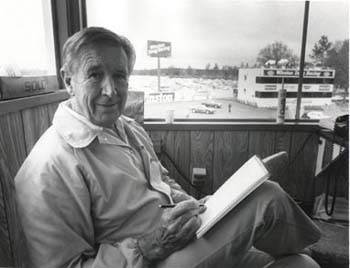NORM FROSCHER – MY FAVORITE INTERVIEWS WITH WALLY PARKS
 When someone passes from
this earth, our most treasured keepsakes are our memories, our way of
celebrating life.
When someone passes from
this earth, our most treasured keepsakes are our memories, our way of
celebrating life.
So it is, with Wally
Parks.
He had many, many friends,
coworkers and associates whom he touched in his busy 94 years.
As were probably you, this
writer was shocked by Wally's passing, even at age 94.
The memories came flooding
in – memories of our times together, in interviews and just an after-the-race
dinner with he and wife Barbara.
Ah yes, interviews.
One of my favorites was when he took time to detail to me the very first Winter Nationals.
First Winter Nationals was in Florida in 1960
 When someone passes from
this earth, our most treasured keepsakes are our memories, our way of
celebrating life.
When someone passes from
this earth, our most treasured keepsakes are our memories, our way of
celebrating life.
So it is, with Wally
Parks.
He had many, many friends,
coworkers and associates whom he touched in his busy 94 years.
As were probably you, this
writer was shocked by Wally's passing, even at age 94.
The memories came flooding
in – memories of our times together, in interviews and just an after-the-race
dinner with he and wife Barbara.
Ah yes, interviews.
One of my favorites was
when he took time to detail to me the very first Winter Nationals.
No, it wasn't at Pomona in
1961, but at Flagler Beach airport, just north of Daytona, the year before, in
1960. Yep, the FIRST Winter Nationals (two words).
Let Wally tell it from an
earlier exclusive interview with this writer:
"We'd been coming
down to Daytona for beach runs since the early fifties, so by 1960 it had built
up to the point where they were they were having drag races on the beach
(although the Daytona 500 was already contested at the new Daytona Speedway).
They were-semi organized and there was also running up and down the streets of
the city and were creating problems," Parks said.
"So Bill France asked us if NHRA would produce a championship event there so as to give the kids, as we called them, some place to run.
a d v e r t i s e m e n t
Click to visit our sponsor's website
 "We agreed and they
made arrangements for us up at the Flagler Beach airport for a three-day
weekend. We brought in a group of people and produced night races under the
name Winter Nationals. Our southeast division director at the time, Ernie
Shore, came up with the title.
"We agreed and they
made arrangements for us up at the Flagler Beach airport for a three-day
weekend. We brought in a group of people and produced night races under the
name Winter Nationals. Our southeast division director at the time, Ernie
Shore, came up with the title.
"It turned out to be
a success as far as eliminating the problems, or at least lessening the
problems in Daytona, although it wasn't a financial success. But it established
a lot of new systems and policies because it was a national event in
nature."
So what about the
Winternationals (one word)?
"The following year
we needed a major event out on the West Coast, because until that time our
second U.S. Nationals was our only major event.
"So we moved the
(February) event to the Los Angeles Fairgrounds in Pomona and named it the
Winternationals, combining the two words into one."
Parks, naturally, had
founded the National Hot Rod Association nearly a decade before that.
"Our efforts to
organize drag racing and time trials went back to the formation of the Southern
California Timing Association, which was a group of car clubs from the Southern
California area which banded together after we got back from World War II. The
organization's main activity was running speed trials up at Muroc Dry Lake,
which was near Edwards Air Force base," Parks recalled during the
interview.
Parks pointed out there
were many problems in those days with street racing and with people creating
problems for police and local citizens.
"We worked with the
California Highway Patrol, the Los Angeles Police and the Pomona Police
Department which assigned officers to work with members of the organized car
clubs. After some experimentation, mostly done by Hot Rod Magazine's staff, we
decided that the quarter-mile was about as far as you could go without running
out of space to get stopped.
"So we worked on
establishing rules, standards and the quarter-mile as the racing distance"
And that was perfect for
another reason.
Parks and his associates
made use of the many abandoned World War II airfields, which as we saw, were
put to a new and peaceful use back in 1946. NHRA was formed in 1951 and by 1953
a program was in place, complete with insurance.
And seven years later,
Florida hosted the first Winter Nationals, as we saw.
For Parks, there was one
anxious moment. Returning from the drag race one night he and Shore were
driving on the beach back to their motel when a police car pulled them over,
maybe thinking they were about to race.
"As soon as we
explained what we were doing and where we'd been, he obligingly wished us good
luck and motioned us on."
a d v e r t i s e m e n t
Click to visit our sponsor's website
This recall of a couple of
interviews and visits with Parks certainly wouldn't be complete without moving
up to 1969.
The late Buster Couch was then NHRA Division 2 Director (Buster's Rebels) and
one of his favorite stops was the new strip that had opened in the University
of Florida college town of Gainesville.
Couch kept telling Parks
it would be an ideal location for a national event for the young NHRA.
Parks decided to have a
look for himself and flew into Jacksonville's airport, where he and an
associate were picked up by Couch.
Buster busily extolled the
virtues of the new strip, the possible attendance, et al, until somewhere at
mid-point, near Starke, he took a wrong turn and got the party lost, at least
briefly, on the way to Gainesville
Finally, Parks did see the
facility.
"We were sold on
it," he said later.
So a national event was
staged in 1970 and the first winners were Dave Chenevert, Top Fuel, Leonard
Hughes, Funny Car, and Bill "Grumpy" Jenkins, Pro Stock.
MY FIRST MEDIA WALLY
There's a picture of my
wall of Wally and Miss Florida flanking me as the former presented me with the
NHRA Media Award in 1975.
"We're going to use
you in the pre-race," he had warned me earlier.
I got him back a couple of
years later, when as president of the American Auto Racing Writers and
Broadcasters Association, I took the pre-race ceremonies opportunity to present
him with a life membership gold card in the association, to which he was always
most helpful.
Heck, his own public
relations guy, Bob Russo, was founder of the group.
Wally, we'll miss you and
Barbara, but every time they fire up the engines, wherever it might be, we'll
give thanks to you and thanks for the memories
| {loadposition feedback} |




